ES6对继承的体会
ES6的class方式对于ES5用构造函数的方式创建类,只是一个语法糖并没有根本性的改变,以下是对static,this,以及继承做一个简单的分析
一、static关键字
1、加了static情况
1 class Person { 2 constructor(name, age) { 3 this.name = name; 4 this.age =age; 5 } 6 7 static say(){ 8 console.log(this.name+","+this.age); 9 } 10 } 11 12 let p = new Person("qbin",22); 13 14 15 console.log([Person]); 16 console.log(p);

此时加了static的say方法作为类的属性,可以直接被类所调用,即Person.say()
2、不加static的情况
class Person { constructor(name, age) { this.name = name; this.age =age; } say(){ console.log(this.name+","+this.age); } } let p = new Person("qbin",22); console.log([Person]); console.log(p);
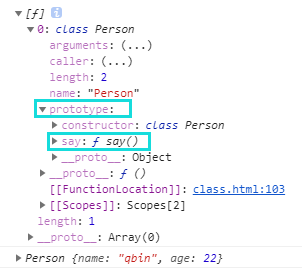
此时say加在了类的prototype属性上,通过我前一篇总结文章中讲到 "构造函数.prototype === 其实例化对象._ _proto_ _",即可了解到对象通过_ _proto_ _拿到与之对应的类上的方法
有些初学者可能会有疑问,其中对象p,没通过_ _proto_ _就成功调用了say()方法,这是为什么?,如下
class Person { constructor(name, age) { this.name = name; this.age =age; } say(){ console.log(this.name+","+this.age); } } let p = new Person("qbin",22);
//此时p没通过__proto__调用say p.say(); console.log([Person]); console.log(p);
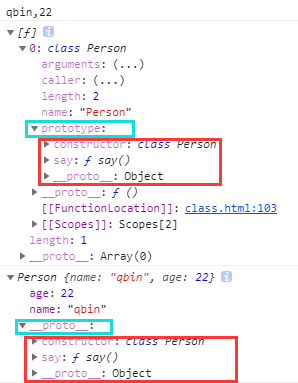
原因是_ _proto_ _默认会一层层自动向下找所需要调用方法,_ _proto_ _可以不写明
二、this关键字
1 class Person { 2 constructor(name,age) { 3 this.name = name; 4 this.age = age; 5 } 6 7 say(){ 8 console.log(this); 9 } 10 } 11 let p = new Person("qbin",22); 12 p.say();
13 console.log([Person]);
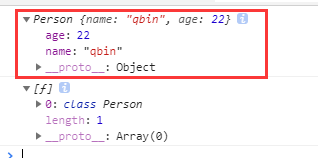
可以看出,this指向实例化对象;当对象进行实例化时,this自动指向对象,并进行赋值初始化
三、继承
1、观察子类的实例化对象z,如何拿到父类的方法
1 class Person { 2 constructor(name, age) { 3 this.name = name; 4 this.age =age; 5 } 6 say(){ 7 console.log(this.name+","+this.age); 8 } 9 } 10 11 class Zhangsan extends Person{ 12 play(){ 13 console.log(this); 14 } 15 } 16 17 let z = new Zhangsan("zhangsan",30); 18 z.say(); 19 20 console.log(z);
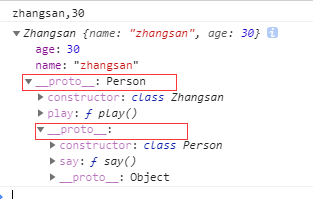
可以看出对象实例,通过一层又一层的_ _proto_ _(原型链)拿到了父类方法say,再一次验证上面所说的_ _proto_ _能自动一层层的向下找所需要调用的方法,直到原型链的顶端
2、观察子类与父类在原型上的关系
1 class Person { 2 constructor(name, age) { 3 this.name = name; 4 this.age =age; 5 } 6 say(){ 7 console.log(this.name+","+this.age); 8 } 9 } 10 11 class Zhangsan extends Person{ 12 play(){ 13 console.log(this); 14 } 15 } 16 17 let z = new Zhangsan("zhangsan",30); 18 z.say(); 19 20 console.log([Person]); 21 console.log([Zhangsan]);

从上图的红框再结合我上一篇总结的文章,我们可以看出 “子类._ _proto_ _ === 父类”
从上图的绿框在结合我们以往在ES5中所使用的原型链继承方式(《JavaScipt高级程序设计》中提及),惊奇的发现,它本质上就是将“父类的实例赋值给了子类的prototype”,实现了继承
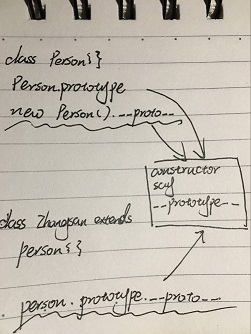 (字不好看,勿怪啊)
(字不好看,勿怪啊)

